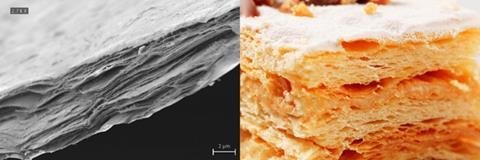Puff pastry-style filter paper is crème de la crème of virus filtration
Researchers in Sweden have made a filter paper with the potential to improve the quality of life for millions of people.1 Made from cheap, sustainable and biodegradable materials, and bearing remarkable similarities to the French pastry, mille-feuille, the filter paper is capable of removing even the smallest viruses from water.

Deaths from drinking contaminated water have halved since 1960, but access to clean water is still a global concern. Adding chlorine is an effective way to decontaminate dirty water, but can generate harmful byproducts and does not deactivate all viruses.
Filtering avoids byproducts by physically removing microorganisms from water. Albert Mihranyan of Uppsala University and colleagues have previously made a filter paper for viruses but it could only trap large ones.2,3 ‘It is extremely challenging to remove small size viruses. It is one thing to build a car but to build a racing car is much more difficult,’ he says.
Now, Mihranyan’s team has made a filter paper with pores petite enough to stop even the smallest viruses getting through. The filter’s pastry-like layers come from hot pressing cellulose nanosheets from Cladophora, green algae notorious for polluting coastal areas.
Teri Dankovich, the chief technical officer at Folia Water, says the filter paper ‘shows great potential for affordable water purification in remote areas’. Last year she created a book with silver-impregnated pages that can filter bacteria from water. She sees the team’s main challenges as ‘determining the filter’s lifespan before microbes and dirt clog the filter’ to see if it has a lifespan long enough for practical use. And Mark Sobsey, an environmental scientist at the University of North Carolina, US, says that although promising, ‘a lot more work is needed before the filter paper can be applied to treating drinking water’.
The team is now scaling up the manufacturing process and developing quality assurance and control protocols. Mihranyan says: ‘For a product dealing with such a specific hazard, it is important to validate, and re-validate, our processes. Every single detail counts and we still have a lot to learn.’
References
1 S Gustafsson et al, Mater. Horiz., 2016, DOI: 10.1039/c6mh00090h This article is free to access until 30 June 2016
2 G Metreveli et al, Adv. Healthcare Mater., 2014, 3, 1546 (DOI: 10.1002/adhm.201300641)
3 M Asper et al, Biologicals, 2015, 43, 452 (DOI: 10.1016/j.biologicals.2015.08.001)












No comments yet